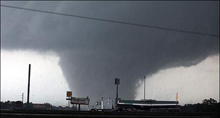When Tuscaloosa News‘ Dusty Compton took a photo of the massive tornado that swept through Tuscaloosa, Ala., Wednesday afternoon, he didn’t know it would land on the cover of The New York Times, USA Today and dozens of other newspapers throughout the country.
As the tornado approached, Tuscaloosa News’ Executive Editor Doug Ray asked Compton and fellow photographer Michelle Carter to get whatever photos they could.
“I had been watching this thing all day, so I knew where the best vantage point was,” Compton told me by phone. “I got in the vehicle and booked it.”
Compton, Carter and online staffer Cory Pennington drove to the highest point in Tuscaloosa and listened to the radio and the scanners to see where the tornado was headed. Hoping to get closer to the tornado — which is part of a southern storm system that has killed more than 200 people — they drove farther west to a parking lot in front of a strip mall that sits parallel to the interstate.
“We were sitting in a mall parking lot and the tornado crested over the hill and came out of nowhere,” Compton said. “It looked like it was coming straight at us.”
Worried about the safety of the people in a shoe store at the mall, Compton, Carter and Pennington drove up to the curb in front of the store and told everyone to take cover at the back of the store where there were fewer windows.
“There were so many things going through my head at the time,” Compton said. “Should I be getting these people to the back of the store? Should I be taking photographs and reporting the news? Should I be calling my family?”
Compton peered through a window at the back of the store and could see how close the tornado was. He then took a chance, opened the back door and started taking photos with Carter. Pennington shot video of the tornado, which was about a quarter of a mile away. They couldn’t give much thought to framing, but captured it as best they could.
-

- Tuscaloosa News photojournalist Dusty Compton captured Wednesday’s tornado from a quarter-mile away.
“You could feel the suction from it pulling on you. All we could think was, ‘That tanker truck is between us and the tornado, and that thing is going to blow the tanker truck on top of us,’ ” Compton said. “I probably pushed it a little too far before I went inside.”
Right after the tornado passed through at about 5:15 p.m., Compton, Carter and Pennington drove to the area that had just been hit and saw complete devastation — houses and buildings destroyed, and endless piles of boards and bricks.
The most challenging aspect of covering the tornado, Compton said, has been figuring out when to intervene.
“We were there before the firefighters and police officers were there yesterday, and we were walking through rubble, not knowing whether everyone was out of it yet,” said Compton. “I wondered, ‘Should I be shooting photos or should I be lifting boards and bricks to see what was underneath it?’ ”
At one point, while Compton was taking photos of a house that had been destroyed, he saw two people calling out a woman’s name. They said they weren’t able to find their friend, who had been in the house that Compton was photographing.
“I put my camera over my shoulder and started calling for this lady’s name,” Compton said. “We didn’t find her there.” The massive tornado has killed 36 people in Tuscaloosa and injured more than 600 there.
Compton, who has worked at the paper for about five years, calls Tuscaloosa an “atmospheric anomaly” — a place where storms seem to “form out of nowhere.” Another tornado swept through Tuscaloosa just two weeks ago, and at the time the paper’s editor told staffers to find shelter in the basement of the newsroom. Compton heeded his advice and ended up just shooting the tornado’s aftermath.
This time around, he covered the storm’s path and its aftermath. Today, he’s been out in the field with a reporter, covering the cleanup efforts. The paper’s photo editor is out this week, so Compton and Carter have been editing their photos themselves. Compton was the one who sent the front page photo to the Associated Press.







Comments